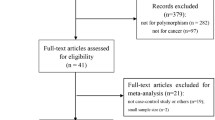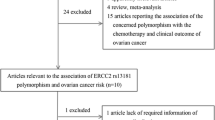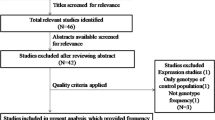Abstract
Glutathione S-transferases (GSTs) are ubiquitous, multifunctional phase II metabolic enzymes responsible for the detoxification of estrogen involved in the development of ovarian cancer. Data from epidemiological studies show conflicting results that remain to be further clarified. We estimated in this study the genetic effects of GSTM1 and GSTT1 polymorphisms on ovarian cancer risk. Eligible studies of the two polymorphisms and ovarian cancer risk were identified from China National Knowledge Infrastructure (CNKI), PubMed, Embase, and Web of Science. We summarized all data and performed a meta-analysis. Odds ratio (OR) and 95 % CI was calculated by using the fixed effects model to estimate the associations. Eight eligible studies were finally identified providing 2,397 cases and 2,910 controls for GSTM1 polymorphism and 2,049 cases and 2,668 controls for GSTT1 polymorphism. The overall data showed that carries of the GSTM1 null genotype did not have significantly increased ovarian cancer risk compared with those who carried the GSTM1 present genotype (null vs. present—OR, 1.01; 95 % CI, 0.91–1.11; heterogeneity, P = 0.672). Similarly, for GSTT1 polymorphism, we observed no association under the investigated model in the overall analysis (null vs. present—OR, 1.02; 95 % CI, 0.89–1.17; heterogeneity, P = 0.372), and in the subgroup of Caucasian subjects (null vs. present—OR, 0.99; 95 % CI, 0.86–1.14; heterogeneity, P = 0.959). The meta-analysis does not provide a strong evidence for causal associations between GSTM1 and GSTT1 polymorphisms and risk of ovarian cancer in Caucasians.





Similar content being viewed by others
References
Jemal A et al. Global cancer statistics. CA Cancer J Clin. 2011;61(2):69–90.
Colombo N et al. Ovarian cancer. Crit Rev Oncol Hematol. 2006;60(2):159–79.
Shih Ie M, Kurman RJ. Ovarian tumorigenesis: a proposed model based on morphological and molecular genetic analysis. Am J Pathol. 2004;164(5):1511–8.
Bell DA. Origins and molecular pathology of ovarian cancer. Mod Pathol. 2005;18 Suppl 2:S19–32.
Roy D et al. Estrogen-induced generation of reactive oxygen and nitrogen species, gene damage, and estrogen-dependent cancers. J Toxicol Environ Health B Crit Rev. 2007;10(4):235–57.
Hayes JD, Flanagan JU, Jowsey IR. Glutathione transferases. Annu Rev Pharmacol Toxicol. 2005;45:51–88.
Garte S et al. Metabolic gene polymorphism frequencies in control populations. Cancer Epidemiol Biomarkers Prev. 2001;10(12):1239–48.
Parl FF. Glutathione S-transferase genotypes and cancer risk. Cancer Lett. 2005;221(2):123–9.
Clapper ML. Genetic polymorphism and cancer risk. Curr Oncol Rep. 2000;2(3):251–6.
Knudsen LE, Loft SH, Autrup H. Risk assessment: the importance of genetic polymorphisms in man. Mutat Res. 2001;482(1–2):83–8.
Oliveira C et al. Polymorphisms of glutathione S-transferase Mu 1 (GSTM1), Theta 1 (GSTT1), and Pi 1 (GSTP1) genes and epithelial ovarian cancer risk. Dis Markers. 2012;33(3):155–9.
Spurdle AB et al. Polymorphisms at the glutathione S-transferase GSTM1, GSTT1 and GSTP1 loci: risk of ovarian cancer by histological subtype. Carcinogenesis. 2001;22(1):67–72.
Baxter SW, Thomas EJ, Campbell IG. GSTM1 null polymorphism and susceptibility to endometriosis and ovarian cancer. Carcinogenesis. 2001;22(1):63–5.
Goodman JE et al. Catechol-O-methyltransferase polymorphism is not associated with ovarian cancer risk. Cancer Epidemiol Biomarkers Prev. 2000;9(12):1373–6.
Lallas TA et al. The glutathione S-transferase M1 genotype in ovarian cancer. Cancer Epidemiol Biomarkers Prev. 2000;9(6):587–90.
Higgins JP et al. Measuring inconsistency in meta-analyses. BMJ. 2003;327(7414):557–60.
DerSimonian R, Laird N. Meta-analysis in clinical trials. Control Clin Trials. 1986;7(3):177–88.
Mantel N, Haenszel W. Statistical aspects of the analysis of data from retrospective studies of disease. J Natl Cancer Inst. 1959;22(4):719–48.
Egger M et al. Bias in meta-analysis detected by a simple, graphical test. BMJ. 1997;315(7109):629–34.
Gates MA et al. Talc use, variants of the GSTM1, GSTT1, and NAT2 genes, and risk of epithelial ovarian cancer. Cancer Epidemiol Biomarkers Prev. 2008;17(9):2436–44.
Hengstler JG et al. Glutathione S-transferase T1 and M1 gene defects in ovarian carcinoma. Cancer Lett. 1998;130(1–2):43–8.
Sarhanis P et al. Epithelial ovarian cancer: influence of polymorphism at the glutathione S-transferase GSTM1 and GSTT1 loci on p53 expression. Br J Cancer. 1996;74(11):1757–61.
Chunhua Z. Clinic research for gene polymorphism of GSTTI and susceptibility of ovarian cancer [article in Chinese]. China: Jilin University; 2008.
Mannervik B et al. Nomenclature for human glutathione transferases. Biochem J. 1992;282(Pt 1):305–6.
Chasseaud LF. The role of glutathione and glutathione S-transferases in the metabolism of chemical carcinogens and other electrophilic agents. Adv Cancer Res. 1979;29:175–274.
Pearson WR et al. Identification of class-mu glutathione transferase genes GSTM1-GSTM5 on human chromosome 1p13. Am J Hum Genet. 1993;53(1):220–33.
Webb G et al. Chromosomal localization of the gene for the human theta class glutathione transferase (GSTT1). Genomics. 1996;33(1):121–3.
Brockmoller J et al. Genotype and phenotype of glutathione S-transferase class mu isoenzymes mu and psi in lung cancer patients and controls. Cancer Res. 1993;53(5):1004–11.
Zhong S et al. Relationship between the GSTM1 genetic polymorphism and susceptibility to bladder, breast and colon cancer. Carcinogenesis. 1993;14(9):1821–4.
Van Hemelrijck M et al. Heterocyclic aromatic amine [HCA] intake and prostate cancer risk: effect modification by genetic variants. Nutr Cancer. 2012;64(5):704–13.
Rebbeck TR. Molecular epidemiology of the human glutathione S-transferase genotypes GSTM1 and GSTT1 in cancer susceptibility. Cancer Epidemiol Biomarkers Prev. 1997;6(9):733–43.
Author information
Authors and Affiliations
Corresponding author
Rights and permissions
About this article
Cite this article
Jin, Y., Hao, Z. Polymorphisms of glutathione S-transferase M1 (GSTM1) and T1 (GSTT1) in ovarian cancer risk. Tumor Biol. 35, 5267–5272 (2014). https://doi.org/10.1007/s13277-014-1685-7
Received:
Accepted:
Published:
Issue Date:
DOI: https://doi.org/10.1007/s13277-014-1685-7




